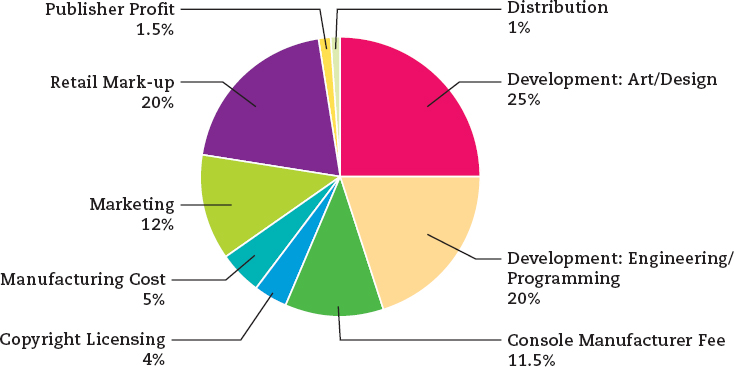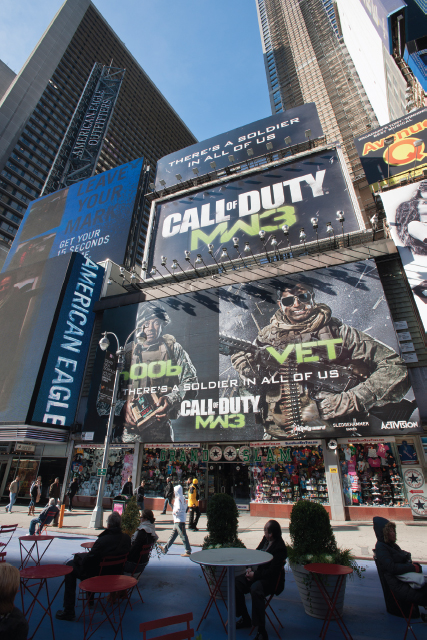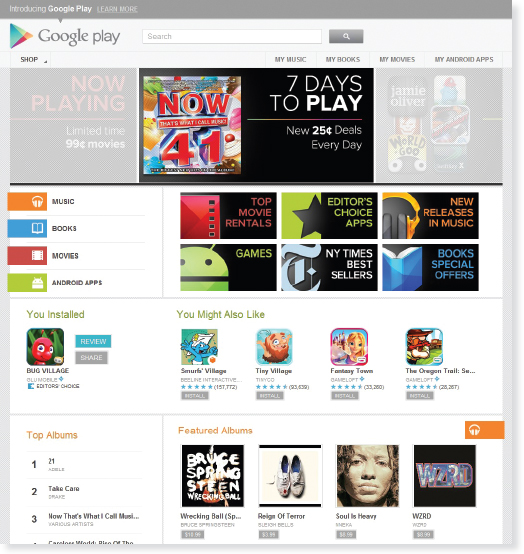The Structure of Digital Game Publishing
“We’ve listened to our players, to what they want from social gaming. They want a place where they can play together, they want a place that curates and delivers the best new social games for them, where they’ll always have a friend to play with.”
JOHN SCHAPPERT, ZYNGA COO, 2012
AAA game titles (games that represent the current standard for technical excellence) can cost as much as a blockbuster film to make and promote. For example, Activision Blizzard’s MMORPG, Star Wars: The Old Republic (2012), took six years of production, with hundreds of programmers, writers, and artists working on the game, as well as an untold number of contract workers. Using recorded voice dialogue, rather than text, Star Wars: The Old Republic has more voice acting than any previous game, online or off. To get the game ready for its global launch, EA assembled 1.6 million players to test an early version of the game.38 Development, licensing, and marketing constitute the major expenditures in game publishing (see Figure 3.2).

Source: Altered Gamer, March 30, 2012, http://www.alteredgamer.com/free-pcgaming/21118-why-are-video-games-so-expensive.
Development
The largest part of the development budget—the money spent designing, coding, scoring, and testing a game—goes to paying talent, digital artists, and game testers. Each new generation of gaming platforms doubles the number of people involved in designing, programming, and mixing digitized images and sounds.
Licensing
Independent gamemakers must also deal with two types of licensing. First, they have to pay royalties to console manufacturers (Microsoft, Sony, or Nintendo) for the right to distribute a game using their system. These royalties vary from $3 to $10 per unit sold. (Of course, if a console manufacturer such as Nintendo makes its own games exclusively for the Wii, then it doesn’t have to pay a console royalty to itself.) The other form of licensing involves intellectual properties—stories, characters, personalities, and music that require licensing agreements. In 2005, for instance, John Madden reportedly signed a $150 million deal with EA Sports that allowed the company to use his name and likeness for the next ten years.39
Marketing
“Like summer blockbusters, these games usually involved quests and wars and bombastic special effects that made them appealing to teenage boys. A Triple-A game could have a production budget of $25 million, with hundreds of developers working on it for years at a time and a $50 million marketing campaign to ensure its ubiquity upon release.”
SAM ANDERSON, NEW YORK TIMES, APRIL 2012
The marketing costs of launching an electronic game often equal or exceed the development costs. The successful launch of a game involves online promotions, banner ads, magazine print ads, in-store displays, and the most expensive of all: television advertising. In many ways, the marketing blitz associated with introducing a major new franchise title, including cinematic television trailers, resembles the promotional campaign surrounding the debut of a blockbuster movie. In 2011, for example, publishers for the two biggest releases of the year—Activision’s Call of Duty: Modern Warfare 3 and EA’s Battlefield 3—each spent more than $100 million on marketing, including an extravagant two-day Call of Duty XP fan event in Los Angeles and an enormous billboard in New York’s Times Square for Battlefield 3. Just as avid fans line up for the midnight release of a new Spider-Man or Hunger Games movie, devoted gamers mob participating retail outlets during the countdown to the midnight launch of a hotly anticipated new game.
Pay Models
There are three main pay models in the electronic game industry: the boxed game/retail model, subscription model, and free-to-play.
The boxed game/retail model is the most traditional, and dates back to the days of cartridges on Atari, Sega, and Nintendo console systems from the 1970s to the 1990s. By the 1990s, games began to be released on CD-ROMs, and later DVDs, to better handle the richer game files. Many boxed games are now sold with offers of additional downloadable content, known as DLC in gaming circles. For blockbuster console games, retail sales of boxed games still reign as the venue for a game premiere. As of 2013, the biggest game launch ever—in fact, the biggest launch of any media product ever—was the September 17, 2013, release of Grand Theft Auto V. The game, published by Rockstar Games, generated more than $1 billion in sales in just three days, better than any other previous game or movie release.40

Some of the most popular games are also sold via subscription models in which gamers pay a monthly fee to play. Notable subscription games include World of Warcraft and Star Wars: The Old Republic. Subscriptions can generate enormous revenue for game publishers. World of Warcraft earns more than $1 billion a year for Activision Blizzard.41 Players first buy the game (either boxed or as a download, at $19.99, with expansions costing $39.99) and then pay a subscription from $12.99 to $14.99 a month. EA’s Star Wars: The Old Republic has a similar subscription cost.
Free-to-play (sometimes called freemium) is the latest pay model, and is common with casual and online games like FarmVille. Free-to-play games are offered online or downloadable for free to gain or retain a large audience. These games make money by selling extras like power boosters (to aid in gameplay) or in-game subscriptions for upgraded play. In addition to free casual games (like Angry Birds Seasons, Bubble Mania, and Temple Run), popular MMORPG games like Sony Online Entertainment’s EverQuest and DC Universe Online also offer free-to-play versions. Even World of Warcraft, the largest MMORPG, began offering free-to-play up to twenty levels of the game in 2011 to lure in new players.
Video Game Stores
Apart from buying boxed game titles at stores like Walmart, Best Buy, and Target, there is really only one major video game store chain devoted entirely to new and used video games: GameStop. The chain, which started in Dallas, Texas, in 1984 as Babbages, today operates more than sixty-six hundred company stores in the United States and in seventeen other countries, including Canada, Australia, Austria, Denmark, Finland, France, and the U.K.42
GameStop stores usually appear in shopping and strip malls, and, beyond video titles, they also specialize in gaming magazines (including their own proprietary title, Game Informer), strategy guides, and video game accessories. For almost a decade (1996–2004), GameStop was owned by Barnes & Noble; then it spun off and merged with their only real competitor, EB Games, in 2005.
Today, the “traditional” brick-and-mortar chain GameStop is trying to negotiate the shifting ground of the digital turn. Some of GameStop’s digital survival strategies include selling customers video game access codes to digital game downloads in the stores, selling Android tablets and refurbished iPads, and investing in other digital gaming companies. Another strategy, also used by retail outlets such as Best Buy, is offering in-store exclusives. For example, those who preordered the Batman title Arkham City from GameStop got special access to the 1990s-era animated series Batman skin for their character. However, those who preordered from Best Buy could get the exclusive offer of playing the game as Robin.
While GameStop gets plenty of attention at the release events of high-profile games, close to 50 percent of the company’s profits are from selling pre-owned titles.43 (Video game publishers don’t like resale of games, since they don’t profit from it.) Yet, even in the used game market, GameStop has stiff competition from Best Buy, Target, Walmart, and Amazon.
Digital Distribution

With the advent and growing popularity of digital game distribution, game players don’t need to go to a department store or retail game shop to buy video games. All three major consoles are Wi-Fi capable and each has its own digital store—Xbox LIVE Marketplace, Wii Shop Channel, and PlayStation Store. Customers can purchase and download games, get extra downloadable content, and buy other media like television shows and movies as the consoles compete to be the sole entertainment center of people’s living rooms. These console-connected digital stores present the biggest threat to brick-and-mortar game stores.
Although the three major console companies control digital downloads to their devices, several companies compete for the download market in PC games. The largest is Steam, with more than forty million subscribers and about 50 percent of the PC game distribution market.44 Steam is owned by Valve Corporation, which used the digital store to help distribute its Counter-Strike game online starting in 2003. Steam also carries more than eighteen hundred games from a wide range of game publishers. Other companies that sell digital game downloads for PCs include Amazon’s Appstore, GameStop, Microsoft’s Games Marketplace, Origin (owned by EA), and GameFly.
Of course, the most ubiquitous digital game distributors are Apple’s App Store and Google Play, where users can purchase games on mobile devices. Although Google’s Android system has surpassed the iPhone in market penetration, Apple customers are more likely to purchase apps, including games. That has drawn more independent developers to work in the Apple operating system. As one technology writer summarized, “Quite simply, developers have long known that Apple device owners are closely locked into the Apple ecosystem, with credit cards on file.” 45